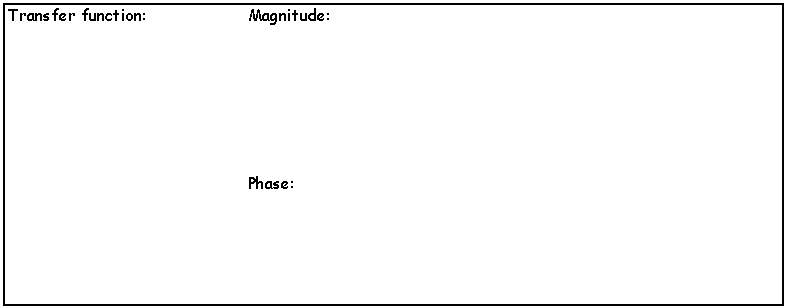|
Lab 1: Review of Basic RC Circuits - EE 420L Author: Mario Verduzco Email: Verdum1@unlv.nevada.edu Date: 01/24/17
|
|
Pre-lab: · Your lab reports will be drafted using html and placed on CMOSedu. · Prior to the first day of lab, but no earlier than one week before the lab starts, request a CMOSedu account, using your UNLV email address, from Dr. Baker (rjacobbaker@gmail.com). · Review the material seen here covering editing webpages (do this before the first lab). · Read the entire write-up seen below before coming to lab
|
|
Lab description: The objective of this lab is to calculate, simulate, and measure the magnitude and phase of the frequency responses of a variety of RC circuits.
|
|
Lab requirements: · Circuit schematic showing values and simulation parameters (snip the image from LTspice). · Hand calculations to detail the circuit's operation. · Simulation results using LTspice verifying hand calculations. · Scope wave forms verifying simulation results and hand calculations. · Comments on any differences or further potential testing that may be useful (don't just give the results, discuss them).
|
|
Experimental Results: Experiment #1: An RC circuit |

|
Experiment #1: Hand calculations
|

|
Experiment #1: Simulations
|

|
Experiment #1: Measurements
|


|
Fig 1.1– LTspice .tran simulation |
|
Fig 1.2– Magnitude of Vout on oscilloscope |
|
Fig 1.3– Phase shift on oscilloscope |
|
Experiment #1: Results |
|
Experiment #1: AC analysis |

|
Fig 1.4– Frequency Response simulation |
|
Table 1.2– Magnitude and phase measurements |
|
Table 1.1– Calculated results compared to simulated and measured results |


|
Fig 1.5– Magnitude response |
|
Fig 1.6– Phase response |
|
Experiment #2: Another RC circuit |


|
Experiment #2: Hand calculations |
|
Experiment #2: Simulations |

|
Fig 1.7– LtTSpice .tran simulation |
|
Experiment #2: Measurements |


|
Fig 1.8– Magnitude of Vout on oscilloscope |
|
Fig 1.9– Phase shift on oscilloscope |
|
Experiment #2: Results |
|
Table 1.3– Calculated results compared to simulated and measured results |
|
Experiment #3: RC circuit Step response |

|
Experiment #3: Hand calculations |

|
Experiment #3: Simulation |

|
Experiment #3: Measurements |
|
Fig 1.10– LtTSpice .tran simulation |

|
Experiment #3: Results |
|
Fig 1.8– Vout step response on oscilloscope |




|
The results from the hand calculations, simulations, and experiment are all very close to each other. |





|
In both the simulation and experiment after 5 time constants the capacitor was fully charged. However with the pulse width of 4ms the capacitor did not fully charge. |
|
Return to Mario Verduzco lab directory Return to student lab reports Return to CMOSedu |
|
The results for this circuit were further apart than the previous experiment. Still within ±10% the circuit did what it was calculated to do. |
|
|
Vout* |
Phase shift ϕ |
Time delay |
|
Hand Calculations |
623mV |
-51.49° |
715us |
|
LTSpice |
617.14mV |
-53.78° |
747.10us |
|
Experimental |
620mV |
-48.96° |
680us |
|
Frequency (Hz) |
Vout Magnitude (mV) |
Phase shift ϕ |
|
50 Hz |
953.86 mV |
-17.47 |
|
100 Hz |
846.03 mV |
-32.35 |
|
200 Hz |
621.434 mV |
-51.57 |
|
500 Hz |
304.26 mV |
-72.29 |
|
1 kHz |
157.46 mV |
-81.00 |
|
10 kHz |
15.91 mV |
-89.10 |
|
159.1 Hz |
-3dB |
-45 |
|
|
Vout* |
Phase shift ϕ |
Time delay |
|
Hand Calculations |
694mV |
-6.84 |
95us |
|
LTSpice |
702mV |
-5.54° |
77us |
|
Experimental |
740mV |
-8.64° |
120us |